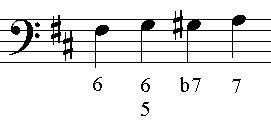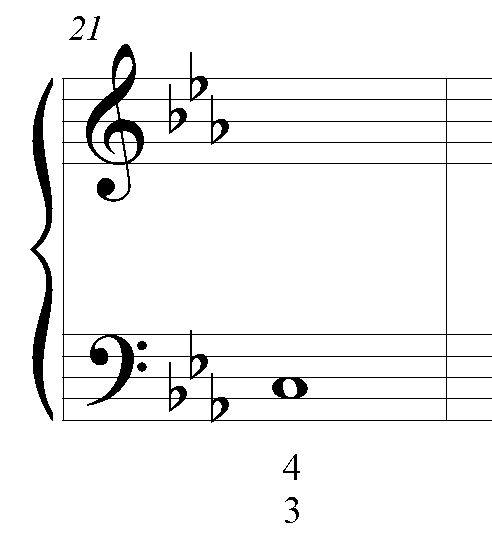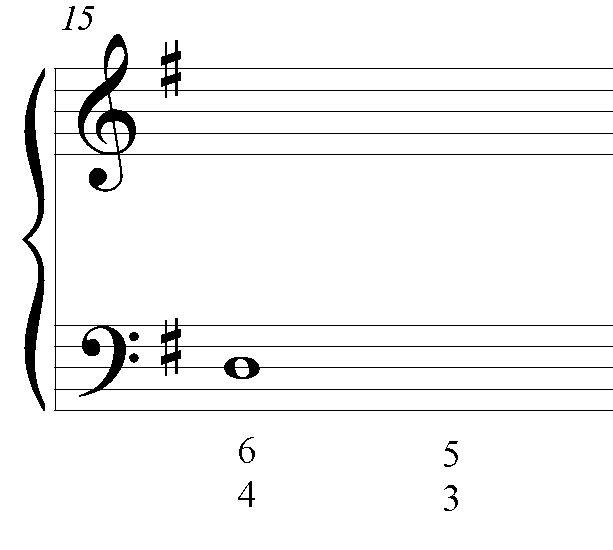
Figured bass inversion numbers & symbols
Theory students often have to realize harmonic progressions indicated by a figured bass: a bass line of notes on the staff, with numbers stacked underneath certain notes.
Most students think of these numeric symbols as representing "first inversion", "second inversion", etc., of a triad or of a seventh chord. When we first learn how to make a first inversion of a triad, for example, we typically stack the notes of the chord up from the root on the staff, and then take the root off the bottom and move it up an octave, leaving the third on the bottom. The notes would then read up from the bottom in order: third, fifth, root.
While this is initially a good way to learn what an inversion is, I do not believe it is the best way to think about inversions when actually analyzing or writing four-part music, such as realizing a figured bass. When the notes of a chord get put into the upper voices (usually into a four-voice SATB voicing, or a four-voice keyboard voicing) they do NOT have to go in order as described above. In other words, in an inversion of a chord in a piece of music, only the note in the bass voice matters - the notes in the upper voices can be in any order above that bass note whatsoever, and do not have to follow in order from the bottom up.
This means that when looking at a figured bass number, you can grasp a lot about what is going on, as long as you translate the meaning of the numbers in a clear way. For example, the symbol 43 is often thought about as meaning a seventh chord in second inversion. But what does “second inversion” mean? That term does not tell you quickly what the chord is, or what the other notes are. I would like to suggest another way to describe the meaning of this symbol that may be more helpful in indicating what chord is present:
When looking at a figured bass symbol,
always ask yourself the following two questions:
Does this symbol imply a triad or a seventh chord?
Is the bass note the root, third, fifth or seventh of the chord?
I believe students can understand figured bass symbols more quickly and easily by thinking that, for example, 43 really means "seventh chord, fifth in bass" rather than “second inversion of a seventh chord”. In other words, the note you are looking at in the bass is the fifth of the chord, and the root of that chord can be quickly found by going down a fifth below that note (Use the staff: if the bass note is on a line, go down two more lines; if it's on a space, go down two spaces.) Once you have identified the root, say the letter names of the notes in the chord in thirds up from that root (don't worry about the sharps or flats just yet). In this case, since the symbol 43 indicated that this chord is a 7th chord, you need to say 4 letters.

Let's do that example one more time, in more detail. In the above musical example, the figured bass has a key signature of three flats, and a C in the bass with the symbol 43 underneath it. Remember, this symbol means "7th chord, fifth in bass." Since the bass note is the fifth, find the root by going down a fifth below the C (use the staff!). You find the root is the note F. Then say the letters in thirds, up from the root F: F A C E. These are the letters in this chord. Even though the key signature adds flats to two of those letters, this will not affect where on the staff those notes need to be placed when voicing the chord. Once you know the root, you can figure out what step of the scale the chord is built on, and this will give you the quality of the chord.
In other words, the most important thing is to find the root of the chord quickly from the figured bass symbol. Once you have the root letter name, you can compute the other letter names needed - three letters for a triad, four letters in a 7th chord. Since there are no accidentals in this symbol, the key signature will take care of making the chord the correct quality. (See below for advice on figures with accidentals in them.) Once you know the letter name of the root, you can then determine the Roman numeral symbol to write in the analysis, showing which chord of the scale it is, and its quality.
If you know which part of the chord the bass note is, it helps you quickly find the root, the other letters in the chord, the quality of the chord, and the Roman numeral symbol.
Remember that in our example above, the root of the 7th chord was F. Since the key signature contained three flats, the key is either E-flat major, or c minor (how do I tell if it's major or minor?). Since we don’t have enough information in this example to tell which key it is, we will analyze in both major and minor. If the key is E-flat, the chord is ii7, since F is the second step of the E-flat scale; since it is a ii7 chord, it will be a minor seventh quality. If the key is c minor, the chord is iv7 instead, and is still a minor seventh quality.
Here is a chart to help you understand the meaning of figured bass numerical symbols. In each case, I have avoided defining them as “second inversion”, etc. Instead, my definition states whether or not the symbol implies a triad or a seventh chord, and which member of the chord is present as the bass note. It will help you to memorize the meaning of these symbols.
no symbol underneath the note - triad, root in bass
6 - triad, third in bass
6
4 - triad, fifth in bass
7 - seventh chord, root in bass
6
5 - seventh chord, third in bass
4
3 - seventh chord, fifth in bass
4
2 - seventh chord, seventh of chord in bass
Once you learn this way of interpreting these figured bass numbers, it makes it easy to quickly find the root of the chord. Finding the root will help you with the analysis by determining the Roman numeral and other notes needed. It may also assist you in learning how to play progressions at the keyboard directly from the figured bass without writing out the upper voices.
Accidentals in figured bass symbols
If you have done figured bass exercises before, you may have encountered accidentals under the bass notes, with or without numbers next to them. The most common example is where there is just a single accidental under a bass note, where there are no numbers present. The first time this is typically encountered is in a dominant triad in a minor key, where the third of the V chord needs to be raised a half step to make it into a leading tone to the tonic note.
This symbol is often interpreted incorrectly to mean "raise the third of the chord." But that is NOT correct. It actually means raise the third above the bass. In the above example, the V chord was in root position, so the third above the bass WAS the third of the chord, but many times accidentals are seen in a stack of numbers (without a number next to them), such as this symbol, which is found quite commonly in figured bass:
6
#
This symbol should be interpreted as described above: the 6 means "triad, third in bass", and the # sign means "raise the note a third above the bass one half step". Thus, since the third of the chord is in the bass, the note being sharped (a third above the bass note) turns out to be to be the fifth of the chord.
Implied figured bass numbers
All numbers in figured bass represent intervals above the given bass note. The figured bass inversion numbers described above are mostly incomplete descriptions of the intervals above the bass necessary to give all the notes in the chord. For example, I stated above that the number 6 beneath a bass note meant “triad, root in bass”. But if we took that symbol literally, the 6 would mean only that there is a note a 6th above the bass note. But since this is triad – what is the third note in the chord?
Figured bass numbers are a shorthand system developed so that a keyboard player would know what chords to play when accompanying a melody. In that respect, they are similar to the kinds of chords symbols (Gm7, A, e7) one might see in a jazz chart, or guitar chords indicated in a popular song.
The important thing about this type of system is that the symbols need to be short and easy to understand – therefore some numbers are eliminated so that there is less clutter, and the chords are easier to read.
For example, since root position triads are the most common type of chord, they are indicated by having no numbers at all under the bass note! But if you think about it, if we wanted to be very literal, those bass notes should have 53 written under them to indicate that we should put a fifth and a third above that bass note. In other words, when we see no numbers under a note, the 53 is implied. We don’t need to see those numbers to know what to do. "Nothing" means something very specific in this case.
You may have actually come across a 53 in a figured bass and wondered what it was. This often occurs when a long bass note is present, and there is more than one chord that needs to take place during the time of that note.
A common example is when there is a I64 – V progression taking place. Imagine a whole note D in the bass voice, with the number 64 right underneath it, but before the next bass note comes, there is a 53 written. (Remember, the whole note is still sounding at the point where the 53 occurs.) This tells you there is a change of harmony, probably two half note chords, above that whole-note bass note.

The figured bass numbers should be interpreted like this: 64 means that the D is the fifth of the chord (so the first half note is a G chord), and the 53 tells you that the D is now the root of the chord (so the second half note is a D chord.) The root position D chord can’t be indicated by writing nothing in the last half of the bar, as is usually done for a root position triad, because that would result in the G64 chord lasting the entire amount of time. This is why the 53 symbol is usually used – to cancel out a previous symbol that is in effect.
Complete figured bass numbers for seventh chords
Since the regular figured bass numbers for seventh chords only contain one or two numbers, there is always at least one number being left out (implied.) These implied numbers are sometimes used when chromatic alterations of the chords need to be made. It is important to recognize that these complex looking symbols are just slightly more complete versions of the regular inversion symbols we learned above. Here are the four types. The leftmost number is the usual inversion number symbol, and the three-number stack is the complete set of intervals found above the bass note. I have added a few accidentals as well, since this is typically why you see them written this way. Take care to note exactly which part of the chord is being raised or lowered.
7 7
#5 indicates a root position 7th chord, with raised 3rd and 5th
#
6 6
5 5 indicates a 7th chord with third in bass, with lowered 5th
b3
b6
4 4 indicates a 7th chord with fifth in bass, with lowered 3rd and 7th
3 b3
6
4 #4 indicates a 7th chord with the 7th in bass, with a raised root and 3rd
2 #2
Now when you look at a complicated figured bass, it will be much easier to sort out what chords are being indicated. These sorts of figured basses with many symbols are actually not hard to realize into four voices, since every note needed is being indicated by a number below, as an interval above the given bass note.
Unusual numbers in figured basses
Sometimes you may discover odd-looking number symbols in a figured bass which are not like any of the typical inversion numbers we have learned above, such as these numbers, both indicated below the same bass note:
7
4 3
Strange number combinations such as this indicate that there are non-chord tones present. Much of the time, these figured bass symbols look somewhat similar to one of the more familiar inversion symbols discussed above. In the example, the 7 seems likely to imply a root position 7th chord. But the 4 is peculiar - it indicates the non-chord tone, which subsequently resolves down to the third of the chord.
Notice that in this case, the non-chord tone displaces the third of the chord, until the moment of resolution. (The above example would create a typical 4-3 dissonance and resolution, possibly a suspension.) Non-chord tones need to resolve, so it may help you to look at the symbols immediately following to decipher which tone has to move to resolution (that note is the non-chord tone), and to determine which real chord tone it is designed to displace. In other words, the note of resolution (the 3rd of the chord in the above example) should be left out of the chord at first (displaced by the 4). The interval of a 4th above the bass should be stuck in instead. In a subsequent beat, that note will resolve by moving down a step, to the note a third above the bass, and the chord will be complete.
There are so many possibilities using non-chord tones that it is impossible to outline all the figured bass number combinations here. Remember these two things: become thoroughly familiar with the regular inversion numbers for triads and seventh chords described above - if the figured bass numbers do not resemble those, it probably means a non-chord tone is being indicated. | 